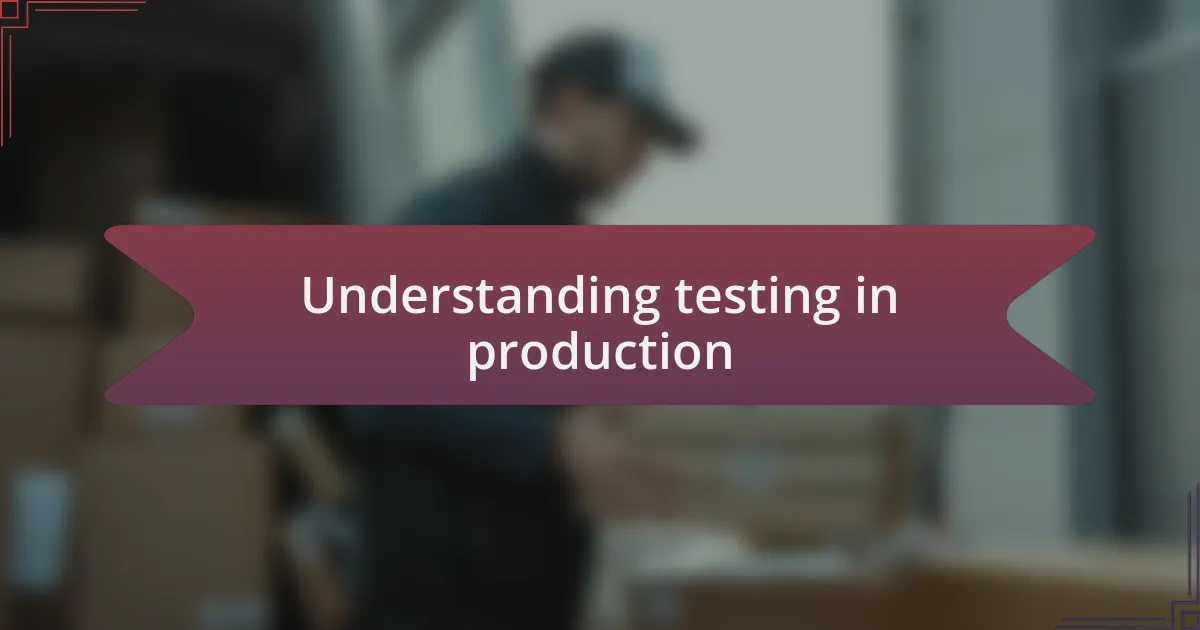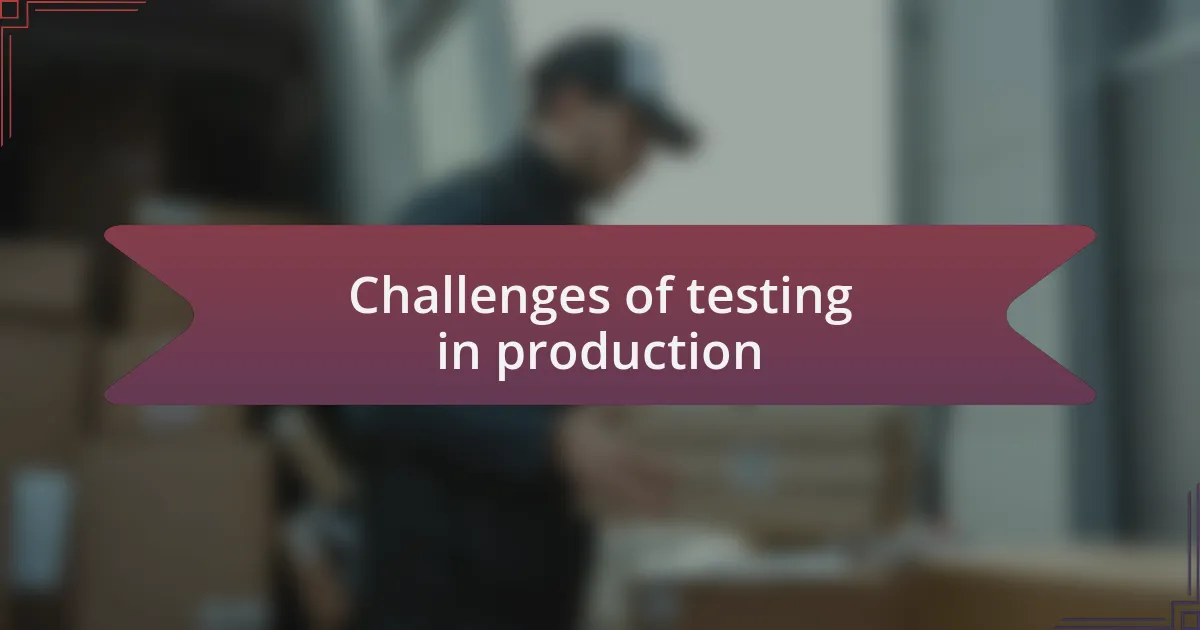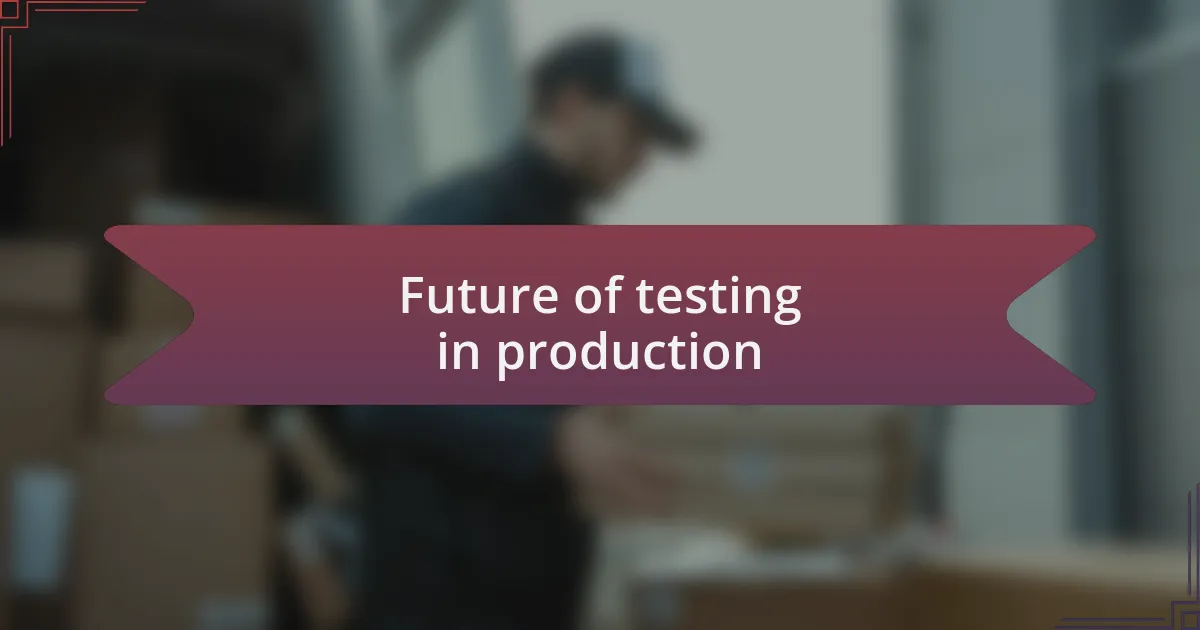Key takeaways:
- Testing in production uncovers hidden issues from real user interactions that may not be seen in staging.
- Effective testing requires careful planning, robust monitoring, and a strong rollback mechanism to mitigate risks.
- Real user feedback is essential for improvement; being adaptable allows teams to pivot strategies based on actual behavior.
- The future of testing emphasizes collaboration between teams, automation, and resilience to enhance efficiency and innovation.

Understanding testing in production
Testing in production is a complex yet crucial part of the software development process. I remember a time when I deployed a feature and it performed seamlessly in staging, but once it hit production, the real-world scenarios uncovered several hidden bugs. Isn’t it fascinating how the nuances of real user interactions can reveal issues we often overlook during development?
When I first embraced this practice, I was hesitant; the thought of experimenting with live users felt daunting. However, I soon realized that testing in production allows for invaluable feedback and faster iterations. Have you ever experienced a situation where a small tweak made a significant difference in user experience? That’s the beauty of testing in a live environment.
It’s essential to balance caution with innovation. I’ve learned that effective testing in production doesn’t mean haphazardly throwing code into the wild; it involves meticulous planning and a robust monitoring system. How often do we underappreciate the importance of quick responses to user behavior? Every insight gained can lead to improvements that not only enhance our software but also build trust with our users.

Challenges of testing in production
Testing in production comes with its own set of challenges that can feel overwhelming at times. One significant hurdle is the inconsistency of user behavior. I remember a project where analytics suggested a feature would be a hit, yet when we launched, real users interacted with it in ways we never anticipated. Have you ever seen your best-laid plans unravel because people simply used things differently? It’s a stark reminder that user experience is often shaped by unpredictable factors.
Another critical challenge is managing the risks associated with testing live. I once rolled out a minor update, only to unwittingly disrupt a key component of our app. That day, I quickly learned the importance of strong rollback mechanisms. Isn’t it scary to think that one small mistake could have wider consequences? It underscores the need for thorough monitoring and readiness to address issues immediately.
Moreover, there’s the emotional journey involved. Watching users interact with your software is both thrilling and nerve-wracking. During one launch, I felt a rush of excitement mixed with nervous anticipation as I monitored user feedback in real time. Have you ever felt that blend of hope and anxiety at such moments? Balancing the thrill of innovation with the fear of failure is undoubtedly one of the most challenging aspects of testing in production.

Lessons learned from real-world testing
Testing in production has taught me that real user feedback can be both a gift and a challenge. I remember a time when a feature I was confident about fell flat. Users weren’t engaging with it as I’d anticipated, and I found myself wondering, “What did I miss?” It was a humbling experience, highlighting the need to embrace feedback and adjust quickly to meet user expectations.
One of the most valuable lessons came from observing the ripple effects of a performance issue shortly after a production release. We had introduced a new capability, and suddenly, our system was under strain. I felt the panic rise as I watched response times slow down. This taught me the crucial importance of performance testing, even if it means revisiting earlier stages of development. It’s those moments that really drive home the significance of proactive monitoring.
Through these experiences, I’ve realized the importance of fostering a culture of adaptability. In one project, a feature test led us to completely pivot our approach mid-sprint based on real-time user interactions. That kind of flexibility can be daunting but ultimately reinforces the idea that the best decisions are informed by actual user behavior, not just theoretical scenarios. Have you ever witnessed a change in direction that ended up transforming your project for the better? It’s moments like these that underscore the dynamic nature of software development.

Future of testing in production
The future of testing in production seems to be moving towards a more integrated approach, emphasizing collaboration between development and operations teams. I recall a project where my team adopted a “shift-right” strategy, testing features not only before release but actively monitoring them in live environments. This collaboration fostered a sense of shared ownership, making it easier to identify issues quickly and resolve them as a unit, rather than placing blame when things went wrong.
As technology evolves, I foresee more organizations embracing automation and machine learning in their testing practices. I experienced firsthand how implementing AI-driven tools helped us analyze user interactions within minutes, revealing patterns that manual reviews might have missed. Have you considered implementing such tools? They have the potential to greatly enhance our efficiency, allowing teams to focus on building rather than troubleshooting.
Additionally, the expectation for continuous deployment will likely sharpen the focus on resilience in testing in production. I remember the anxiety I felt during a critical deployment when a minor bug surfaced just after our release. It drove home the need for robust rollback procedures and real-time monitoring. Isn’t it fascinating how scaling our systems and processes for resilience can transform testing from a burdensome task into an enabler of innovation? The future, as I see it, invites us to embrace risk, knowing that adaptability is key to thriving in an ever-changing landscape.